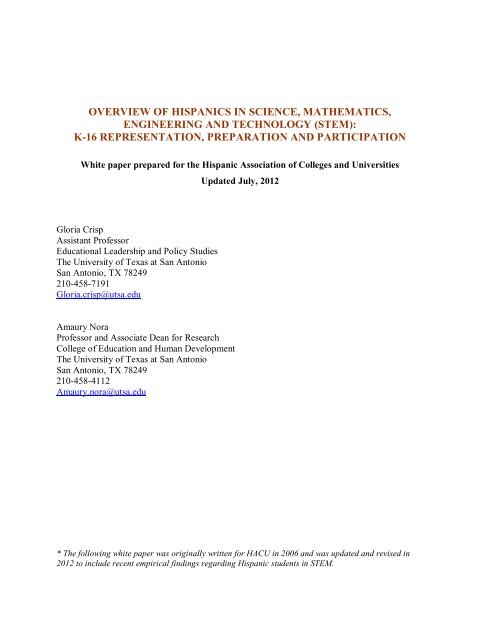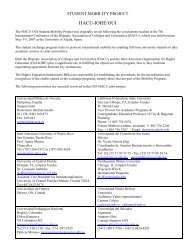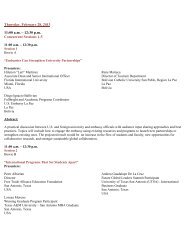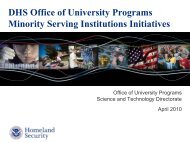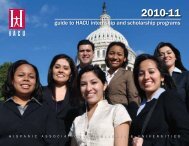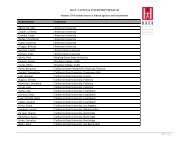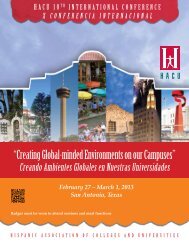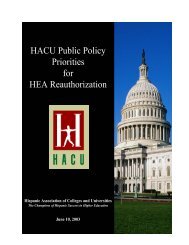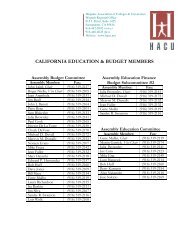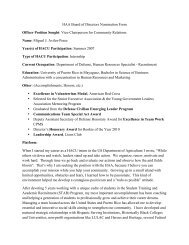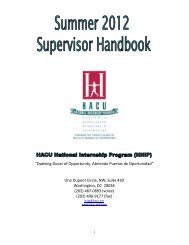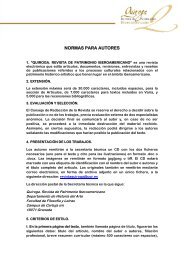AN OVERVIEW OF HISPANICS IN SCIENCE, MATHEMATICS,
AN OVERVIEW OF HISPANICS IN SCIENCE, MATHEMATICS,
AN OVERVIEW OF HISPANICS IN SCIENCE, MATHEMATICS,
Create successful ePaper yourself
Turn your PDF publications into a flip-book with our unique Google optimized e-Paper software.
<strong>OVERVIEW</strong> <strong>OF</strong> HISP<strong>AN</strong>ICS <strong>IN</strong> <strong>SCIENCE</strong>, <strong>MATHEMATICS</strong>,<br />
ENG<strong>IN</strong>EER<strong>IN</strong>G <strong>AN</strong>D TECHNOLOGY (STEM):<br />
K-16 REPRESENTATION, PREPARATION <strong>AN</strong>D PARTICIPATION<br />
White paper prepared for the Hispanic Association of Colleges and Universities<br />
Updated July, 2012<br />
Gloria Crisp<br />
Assistant Professor<br />
Educational Leadership and Policy Studies<br />
The University of Texas at San Antonio<br />
San Antonio, TX 78249<br />
210-458-7191<br />
Gloria.crisp@utsa.edu<br />
Amaury Nora<br />
Professor and Associate Dean for Research<br />
College of Education and Human Development<br />
The University of Texas at San Antonio<br />
San Antonio, TX 78249<br />
210-458-4112<br />
Amaury.nora@utsa.edu<br />
* The following white paper was originally written for HACU in 2006 and was updated and revised in<br />
2012 to include recent empirical findings regarding Hispanic students in STEM.
<strong>OVERVIEW</strong> <strong>OF</strong> HISP<strong>AN</strong>ICS <strong>IN</strong> <strong>SCIENCE</strong>, <strong>MATHEMATICS</strong>,<br />
ENG<strong>IN</strong>EER<strong>IN</strong>G <strong>AN</strong>D TECHNOLOGY (STEM): K-16 REPRESENTATION,<br />
PREPARATION <strong>AN</strong>D PARTICIPATION<br />
The purpose of the following paper is to summarize what is currently known regarding<br />
Hispanic students in STEM. We begin with a summary of pre-college circumstances known to<br />
influence Latino/a students’ decisions to major in STEM as undergraduate students. A synthesis<br />
of what is known to date regarding the factors impacting the retention of Hispanic students in<br />
STEM fields is then provided. We conclude with key recommendations for research, policy and<br />
practice.<br />
A focus on science, technology, engineering and mathematics (hereinafter referred to as<br />
STEM) fields in education is needed for the United States to maintain its competitive position in<br />
a global economy (Chen & Weko, 2009). Analysts predict that the United States needs to<br />
produce approximately one million more STEM professionals over the next ten years, which<br />
equates to increasing the number of students earning STEM degrees by nearly 35% per year over<br />
current rates (President’s Council of Advisors on Science and Technology, 2012). Colleges and<br />
universities are therefore facing an unprecedented need to increase the number of undergraduate<br />
students who are interested in majoring in STEM disciplines (Wang, 2012). There is a large<br />
portion of students who are currently not fully participating in science and engineering (Sevo,<br />
2009). The United States currently has one of the lowest rates of STEM to non-STEM bachelor’s<br />
degree production worldwide, with STEM accounting for 17% of all degrees awarded in the<br />
United States in 2002 compared to the international average of 26% (Kuenzi, 2008).<br />
The demand for skilled workers in STEM fields will be difficult, if not impossible, to<br />
meet if the nation’s future mathematicians, scientists, engineers, information technologists,<br />
computer programmers, and health care workers do not reflect the diversity of the population<br />
(Institute for Higher Education Policy (IHEP), 2010). Hispanics are the fastest growing and<br />
youngest group in the United States. It is estimated that Hispanics will comprise 30 percent of<br />
the U.S. population by 2040 and will be the majority group in several states (U.S. Census<br />
Bureau, 2008). At the same time however, Hispanic students are underrepresented in STEM<br />
fields (U.S. Commission on Civil Rights, 2010). As such, filling the pool of qualified applicants<br />
for employment in STEM fields will require a growing number of Hispanic students studying<br />
STEM fields and earning STEM degrees (Oakes, 1990). Increasing the percentage of Hispanics<br />
and other traditionally underrepresented minorities in STEM occupations is not only ethically
and morally correct, as these groups deserve equal access to STEM fields, but allows minority<br />
groups to serve as role models and mentors for younger members of their own ethnic/racial<br />
group (Bonous-Hammarth, 2000; Grandy, 1998).<br />
Current representation of Hispanics in STEM<br />
The number of students (both Hispanic and non-Hispanic) enrolling in STEM fields is on<br />
the rise. Enrollment in STEM fields from 1995-1996 to 2003-2004 increased 21 percent,<br />
compared to an increase of 11 percent in non-STEM areas. During that same time, the percent of<br />
Hispanic students enrolling in STEM fields increased by 33 percent, representing nearly ten<br />
percent of students in STEM fields (United States Government Accountability Office, 2005). At<br />
the same time however, disproportionately low numbers of Hispanics currently persist in STEM<br />
(Oakes, 1990; Young, 2005). Although Hispanic students have been shown to be equally likely<br />
as White students to major in STEM, they are significantly less likely to earn a degree or<br />
certificate in a STEM field (Chen & Weko, 2009). According to recent data from the Higher<br />
Education Research Institute (2010), 16 percent of Hispanic students who began college in 2004<br />
as STEM majors completed a STEM degree by 2009, compared to 25 percent of White students.<br />
Data from the Integrated Postsecondary Education Data System (IPEDS) Completion<br />
Survey for the 1999-2000 academic year points out that the most popular majors in which<br />
Hispanic students earned bachelor’s degrees are in the social sciences, business, psychology, and<br />
education. In contrast, Hispanic students are less likely to earn undergraduate degrees in<br />
biological and life sciences, computer and information sciences, engineering, and the health<br />
professions and related sciences. These discrepancies that exist at the undergraduate level are<br />
also seen at the master’s and doctoral levels, as Hispanic students are more likely to earn degrees<br />
in education and are less likely to earn a master’s degree in the health professions, engineering,<br />
computer information sciences, and business (Llagas & Snyder, 2003).<br />
Federal STEM Initiatives<br />
The importance of increasing the number of undergraduate Hispanic students completing<br />
degrees in science, mathematics and engineering has been recognized by Congress in the Goals<br />
2000 Educate America Act (section 102, 5Biii). In response, the federal government has<br />
allocated billions of dollars to increase funding earmarked for post-secondary STEM programs<br />
such as the Louis Stokes Alliance for Minority Participation (LSAMP), Federal TRIO Programs<br />
and the Minority Engineering Programs (MEP) (United States Government Accountability<br />
Office, 2005). Although federal STEM programs may provide critical support for a select group
of minority students in the form of summer programs, internships and career counseling, they do<br />
not address the underlying structural and institutional problems influencing the<br />
underrepresentation of Hispanic and African American students in STEM fields. Moreover, there<br />
are limits to the number of students these programs can serve. As such, STEM policy makers and<br />
institutional leaders cannot rely on federal programs alone to increase the number of STEM<br />
degrees earned by Latino/as (Bensimon & Dowd, 2012).<br />
Role of Hispanic Serving Institutions<br />
Minority Serving Institutions (MSI’s) have been identified as key intermediaries to<br />
improve the availability, quality and diversity of the STEM pipeline (IHEP, 2010). Hispanic<br />
Serving Institutions 1 (HSI’s) in particular, have the potential to increase the number of STEM<br />
degrees awarded to Hispanic students, as about half of all Hispanic undergraduate students<br />
currently attend Hispanic Serving Institutions (Dowd, Malcolm, & Bensimon, 2009) and 40<br />
percent of the undergraduate degrees awarded to Hispanics are granted by HSI’s (Dowd,<br />
Malcolm & Macias, 2010). Further, a fifth of all bachelor’s degrees awarded to Hispanic<br />
students in STEM majors are from HSI’s (Dowd, Malcolm & Macias, 2010). It should be noted<br />
that due to the large concentration of Hispanic students in community colleges, over half (53%)<br />
of all HSIs are community colleges (Benitez & DeAro, 2004).<br />
Factors Influencing the Representation of Hispanic Students in STEM Majors<br />
The majority of STEM research to date has focused on predicting persistence and degree<br />
attainment rather than students’ interest in and choice to major in STEM (Wang, 2012).<br />
However, as the following section demonstrates, there is a growing body of work to support the<br />
relative importance of K-12 academic experiences, cognitive factors, and socio-cultural factors<br />
influencing Hispanic students’ decisions to major in STEM as undergraduate students.<br />
Academic Experiences<br />
Mathematical and science training at the elementary and secondary levels has been<br />
shown to influence the academic preparation of students as well as their interests in high school<br />
mathematics and science coursework and in pursing a STEM career (Eamon, 2005; United States<br />
Government Accountability Office, 2005). Further, there is evidence that the number of<br />
mathematics, science, and English courses taken by high school students serves as a major<br />
predictor of choosing a STEM college major (Astin & Astin, 1992; Simpson, 2001). This fact,<br />
1 A Hispanic Serving Institution (HSI) is defined as a college or university that has at least 25% Hispanic full-time<br />
enrollment, of which at least 50% are low income (Bordes & Arredondo, 2005).
while positive for non-minority students, creates a barrier for many minority students due to a<br />
lack of resources needed to foster their learning in science and mathematics (Peng, Wright, &<br />
Hill, 1995; Auerbach, 2004). Unfortunately, the quality of the academic preparation many<br />
Hispanic students receive is negatively impacted by disparities in teacher quality, school funding,<br />
and monies spent on instructional resources. Hispanic students are more likely to be taught<br />
science by teachers who did not major in that field or by inexperienced teachers. Hispanic<br />
students are also more likely than White students to be exposed to funding inequities in the K-12<br />
educational system (Young, 2005). Overall, the current system used for funding school districts<br />
is not equal across districts and Hispanic students are less likely to have access to challenging,<br />
high-quality math instruction, further discouraging an interest in mathematics or science (Berry,<br />
2005; Chacon, 2000; Triana & Rodriguez, 1993).<br />
The type of institution that a student selects to attend has also been cited as a factor<br />
influencing access to and participation in STEM fields for Hispanic students. Students who<br />
attend a four-year institution and arrive on campus with a strong research focus have been shown<br />
to be more likely to major in engineering as opposed to majoring in business or the physical<br />
sciences (Astin, 1993). Unfortunately, less than half of Hispanic students who graduate from<br />
high school qualify to enroll at a four-year institution immediately following graduation<br />
(President’s Advisory Commission, 2002). In turn, the majority of Hispanic students (68%)<br />
attend a community college, thereby decreasing their odds of majoring in STEM (Pew Hispanic<br />
Center, 2005).<br />
Cognitive Factors<br />
Students’ self-efficacy has been shown to be the strongest predictor of the consideration<br />
of mathematics as a career choice (Post-Krammer & Smith, 1986). Leslie, McClure and Oaxaca<br />
(1998) found that the probability of choosing engineering or science increases with students’<br />
perceptions that they possess a solid science/math background and in the belief that he or she has<br />
the ability to perform well in those courses. Additionally, the importance of self-efficacy in<br />
predicting performance and motivation in mathematics for Hispanic students was validated by<br />
Stevens, Olivarez, Lan, and Tallent-Runnels (2004). Unfortunately, Hispanic students (and<br />
minority students more generally) have been shown to have lower levels of self-efficacy when it<br />
comes to science and mathematics as compared to White students (Leslie, McClure & Oaxaca,<br />
1998; Stevens, Olivarez, Lan, & Tallent-Runnels, 2004). Further, there is evidence that Hispanic<br />
students may have difficulty perceiving themselves as scientists, even when they express an
interest in science careers (Sorge, Newsom, & Hagerty, 2000).<br />
Socio-Cultural Factors<br />
Peer influence has also been shown to inspire students’ decisions to major in a STEM<br />
field. Astin and Astin (1992) found that the most consistent environmental influence on a<br />
student’s choice of major is the number of friends and peers that students possess or knew that<br />
were seeking a degree in that field of study. In addition to the overall influence that is exerted by<br />
peers to seek a STEM degree, among Latina students patterns of socialization differ for those<br />
aspiring toward more traditionally male-dominated careers (Reyes, Kobus, & Gillock, 1999).<br />
These female Hispanic students report a greater preference for socializing with a more<br />
heterogeneous group when compared to Latinas aspiring toward a traditionally<br />
female-dominated career. Perhaps the exposure to a more diverse group of aspirations, career<br />
possibilities and thoughts that are not gender-restricted may offer Latinas much more options<br />
including majoring in STEM fields.<br />
The importance of a family support system for minority students in developing and<br />
encouraging a student’s interest in science and mathematics as a career has been shown to be<br />
important (Catsambis, 1994). In fact, parental encouragement has been shown to be one of the<br />
strongest influences on Hispanic students’ early educational aspirations (Arbona & Nora, 2007).<br />
Not surprisingly, Hispanic males living in households where at least one parent is engaged in<br />
engineering or physical science as an occupation are more likely to select engineering as a major<br />
(Leslie, McClure, & Oaxaca, 1998). The researchers concluded that having a parent working in<br />
an engineering or science-related field is instrumental in forming the belief among Hispanic<br />
males that a career in STEM is a realistic goal. In much the same fashion, Latina students who<br />
develop an early interest in highly male-dominated careers such as STEM fields are likely to<br />
have a better understanding of the steps needed to achieve their career goals and objectives<br />
(Reyes, Kobus, & Gillock, 1999).<br />
Moreover, the anticipation of major social events in the lives of Hispanics has a<br />
consequence on their choice of majors. Leslie, McClure and Oaxaca (1998) found that for<br />
Hispanic men, marriage or plans for marriage had a positive influence on selecting engineering<br />
or science as a major. For Hispanic women, marriage plans were found to have the largest<br />
negative impact on the probability of majoring in the biological sciences. It could be argued that<br />
the anticipation of major family responsibilities may discourage Latinas from seeking what could<br />
be perceived as long academic careers such as medicine or doctoral programs.
Factors Specific to Latinas<br />
Gender serves as one of the most powerful and robust predictors of choice of college<br />
major for minority students, as female minority students are much more likely to pursue liberal<br />
arts, health, public service or business degrees than STEM degree programs (Simpson, 2001). In<br />
turn, minority women are currently the most underrepresented group in the fields of science and<br />
mathematics. Despite this gross inequity, few researchers have attempted to understand how<br />
women of color perceive and experience science and mathematics. What is known is that<br />
differences in attitudes can be seen as early as junior high school, at which time Latina students<br />
may be more hesitant to ask questions during class discussions, less likely to report that they are<br />
looking forward to taking eighth grade mathematics classes, and are the least likely of any group<br />
to have STEM career aspirations (Catsambis, 1994). Several cultural features among Latinas<br />
may impact the choices they make as to what careers to pursue. Bowman (1993) and Marin<br />
(1993) found that Hispanic female students raised in a predominately patriarchal family structure<br />
are much more likely to consider STEM careers. Perhaps the encouragement from a father to his<br />
daughter to consider “male career options” may counter sexist attitudes that society might<br />
associate with specific careers in spite of displaying more traditional gender roles and adhering<br />
to loyalty and respect for family. Further, Reyes, Kobus, and Gillock (1999) also found that<br />
Latina students aspiring toward male-dominated careers preferred having “American” friends<br />
and preferred using English in conversation.<br />
Factors Influencing the Retention of Hispanic Students in STEM Majors<br />
Although a major emphasis in the literature is the recruitment of Hispanic students into<br />
STEM majors and careers, an equal amount of attention should also be paid to research on<br />
Hispanic student persistence in the major (Fenske, Porter & DuBrock, 2000). The following<br />
section provides a summary of the socio-demographic variables, pre-college experiences,<br />
environmental pull factors, perceptions/attitudes, college experiences and institutional variables<br />
shown to be related to STEM degree attainment among Hispanic students.<br />
Gender<br />
Findings to date suggest that there is a relationship between a students’ gender and both<br />
college grade point average and whether or not Hispanic students earn a STEM undergraduate<br />
degree. Work by Cole and Espinoza (2008) found that gender predicted college grade point<br />
average among STEM majors. It is notable that although Latinas have been consistently found to<br />
be less likely to earn a STEM degree (e.g., Crisp, Nora and Taggart, 2010), findings by Cole and
Espinoza suggest that Latina students may on the whole earn higher grades than Latinos. This<br />
finding suggests that the challenges faced by females in STEM may be less academic and more a<br />
product of socio-cultural or other issues.<br />
Pre-college Factors<br />
There is also a growing body of evidence to show that pre-college characteristics play an<br />
important role in explaining differences in STEM persistence across ethnic groups, as differences<br />
in STEM persistence have been shown to disappear when pre-college characteristics are<br />
controlled (Chang, Sharkness, Newman & Hurtado, 2010). Among Latina/o and other minority<br />
groups, the likelihood of persisting in a STEM major has been shown to be strongly related to<br />
various pre-college experiences and behaviors including standardized test scores (Garcia &<br />
Hurtado, 2011), high school percentile (Crisp, Nora & Taggart, 2010), high school GPA (Herrera<br />
& Hurtado, 2011) as well as the number of advanced placement courses taken in STEM fields<br />
prior to college (Griffith, 2010). It is important to note pre-college experiences and behaviors are<br />
interrelated. Research by Barton (2003) reveals that Hispanic students who earned a SAT math<br />
score of 550 or higher reported higher levels of participation in science and mathematics clubs,<br />
were enrolled in decidedly more advanced placement courses, and were subsequently more<br />
likely to remain in college and dedicated to earning a degree in a STEM field.<br />
Environmental Pull Factors<br />
Financial concerns, family responsibilities and full-time work commitments have all been<br />
shown to be factors external to the college that “pull” Hispanic students away from STEM fields.<br />
Because science, engineering and mathematics degrees often take longer to complete than other<br />
college majors, financial aid takes on added importance in retaining students in those programs<br />
(Barton, 2003; Fenske, Porter, & DuBrock, 2000). As such, the importance of financial aid on<br />
keeping Hispanic students interested and enrolled in STEM majors/careers cannot be overstated.<br />
The availability of adequate financial resources has been rated as one of the top five factors<br />
related to the persistence of minority engineering students by The National Action Council for<br />
Minorities in Engineering (Landis, 1985). More recently, Hurtado, Han, Saenz, Espinosa,<br />
Cabrera and Cerna (2007) found that Hispanic and African American science students who had<br />
concerns regarding financing their college and family responsibilities that interfered with their<br />
education were less likely to feel that they are able to successfully manage their academic<br />
environment during the first year of college. Additionally, financial concerns were shown to<br />
negatively influence minority science students’ sense of belonging during the first year.
Conversely, as one would expect, the numbers of hours per week spent doing homework or<br />
studying was found to have a positive impact on minority science students’ adjustment in college<br />
(Hurtado, et al., 2007). Furthermore, recent findings by Chang, Sharkness, Newman & Hurtado<br />
(2010) indicate that working full-time may serve to decrease the likelihood that Hispanic and<br />
African American students will persist in a STEM major as undergraduates.<br />
Attitudes/Perceptions<br />
Hispanic students’ attitudes and perceptions of both themselves and the academic<br />
environment have been shown to influence students’ decisions to remain in a STEM major<br />
during college. To begin with, Chang, Sharkness, Newman and Hurtado (2010) found that<br />
having a high academic self-concept serves to increase Hispanic and African American students’<br />
odds of persisting in a STEM major. There is also some evidence that personal values and<br />
personality traits influence persistence in STEM. Findings by Herrera and Hurtado (2011)<br />
suggest that the degree to which Hispanic and African American students feel it is important to<br />
enroll in college to gain career training may be positively related to retaining STEM interest. At<br />
the same time, students who express the importance of leadership potential are less likely to<br />
retain their STEM career interests.<br />
Empirical findings suggest that Hispanic and non-Hispanic students have equally positive<br />
attitudes and similar aspirations for STEM majors/careers. However, as minority students<br />
progress through college, their interest in mathematics and science has been shown to weaken as<br />
academic achievement in these classes declines (Peng, Wright, & Hill, 1995). Persistence in a<br />
STEM major has also been shown to be related to the perceived quality of instruction (United<br />
States Government Accountability Office, 2005). Conversely, satisfaction with the quality of a<br />
student’s academic program has been cited as a leading factor in degree attainment for both<br />
minority and non-minority students (Eimers, 2001). Findings provided by the Educational<br />
Testing Service (1989) note that when high achieving minority students perceive their science,<br />
mathematics or engineering coursework as enjoyable, students are much more likely to persist in<br />
their chosen field (as cited in Barton, 2003). Further, a study by Herrera and Hurtado (2011)<br />
recently found that satisfaction with math and science coursework was the only variable related<br />
to perceptions of the environment that significantly predicted Hispanic and African American<br />
students’ retained interest in STEM. Finally, work by Hurtado and colleagues reveals that<br />
minority students’ feelings they will be successful in managing the academic environment as
well as the likelihood of persisting in STEM may be negatively influenced by perceptions of a<br />
hostile racial climate (Garcia & Hurtado, 2011; Hurtado et al., 2007).<br />
College Experiences<br />
A variety of college experiences have been shown to be related to outcomes among<br />
Latino/a STEM majors including: (1) participating in an undergraduate research program, (2)<br />
participating in a club related to students’ major, (3) time spent studying alone or with others, (4)<br />
engagement with faculty, (5) academic advising from upper-classmen, (6) enrolling in key<br />
gatekeeper courses during the first year, and (7) aspirations toward attending medical school.<br />
The positive influence of minority students participating in undergraduate research programs is<br />
well documented (Astin & Astin, 1992; Chang, Sharkness, Newman & Hurtado, 2010; Garcia &<br />
Hurtado, 2011; Herrera & Hurtado, 2011; Jones, Barlow & Villarejo, 2010). Additionally, as one<br />
would expect, there is a good amount of evidence to suggest that joining a STEM related club<br />
and/or studying (alone or with others) may serve to retain minority students in STEM (Chang,<br />
Sharkness, Newman & Hurtado, 2010; Garcia & Hurtado, 2011; Herrera & Hurtado, 2011).<br />
Time studying with other students may or may not be negatively related to Latino/a STEM<br />
major’s grade point average however (Cole & Espinoza, 2008).<br />
In contrast, there is less agreement as to whether engagement/interactions with faculty<br />
may be beneficial or harmful to minority students’ interest in STEM. While some studies have<br />
found a positive relationship between faculty engagement and STEM outcomes among minority<br />
students (Cole & Espinoza, 2008; Grandy, 1998), more recent findings have found faculty<br />
interactions to be negatively associated with persistence in STEM (Chang, Sharkness, Newman<br />
& Hurtado, 2010; Garcia & Hurtado, 2011). At the same time, receiving advice or other forms of<br />
support from peers, upper-classmen, graduate students and/or teaching assistants have all been<br />
shown to positively shape minority students’ sense of belonging (Hurtado et al., 2007).<br />
Moreover, findings by Hurtado et al. (2007) suggest that interactions with peers of diverse racial<br />
backgrounds has a positive influence on minority science majors’ sense of belonging during the<br />
first year of college.<br />
Research findings also suggest that minority students may face challenges in<br />
“gatekeeper” courses. Some introductory science and mathematics courses may serve to<br />
discourage students’ interest in a STEM degree as a result of highly competitive classroom<br />
environments or an absence of engaging pedagogy that promotes active participation (Gainen,<br />
1995; Seymour & Hewitt, 1997). For instance, recent findings by Crisp, Nora and Taggart (2010)
found that the odds of earning a STEM degree were lower for students enrolled in Algebra I or<br />
higher or Biology I or higher in their first semester.<br />
Institutional Variables<br />
As is the case with other student outcomes, the type of institution that students attend<br />
appears to influence student persistence in STEM fields. Astin and Astin (1992) first established<br />
that students attending small four-year institutions were more likely than not to persist in their<br />
science majors. Additionally, early work by Grandy (1998) showed that minority students who<br />
enrolled in four-year colleges as opposed to attending a community college during their<br />
sophomore year were more likely to complete a STEM major. More recent work by Herrera and<br />
Hurtado (2011) suggests that while attending a private institution may serve to promote<br />
persistence in STEM among minority students, attending a selective institution (as measured by<br />
average SAT score) may have a negative impact on minority persistence in STEM. This finding<br />
suggests that selective institutions may be less supportive of STEM students from<br />
underrepresented groups. Additionally, Hurtado et al. (2007) found that after controlling for<br />
student ability, Hispanic and African American science majors attending selective institutions<br />
had lower assessments of their sense of academic success. Further, a negative relationship was<br />
found between institutional selectivity and minority science students’ sense of belonging during<br />
the first year of college.<br />
Researchers have also begun to explore institutional factors (beyond institutional type)<br />
that influence students’ decisions to persist in a STEM major. Although not specific to Hispanic<br />
students, Eagan, Hurtado and Chang (2010) found that the number of undergraduate research<br />
opportunities offered by institutions was significantly and positively related to the STEM degree<br />
completion rate at the institution. Results also showed that institutions that offered more<br />
retention programs for all students had higher STEM completion rates, relative to non-STEM<br />
degrees awarded. However, this effect was no longer significant when institutional selectivity<br />
was added to the model. Additionally, work by Griffith (2010) identified several institutional<br />
level variables that were related to minority students’ decision to persist in STEM to their<br />
sophomore and/or senior year including the ratio of undergraduate to graduate students, the<br />
percentage of female faculty in STEM, research and educational expenditures, and the<br />
percentage of minority doctoral students. Additionally, recent work by Herrera and Hurtado<br />
(2011) found that minority students’ retained interest in STEM to be influenced by the<br />
percentage of students in STEM majors at an institution.
Recommendations for Research<br />
Although there is a growing body of work to explain the factors influencing Hispanic and<br />
other minority students’ decisions to major and persist in STEM, there is still a great deal of<br />
work to be done. In the bullets below, we offer key recommendations for work that we feel is<br />
needed to advance this line of research.<br />
Additional research is needed to extend what is known regarding the factors that predict<br />
persistence for Latino/a students with an interest in STEM (both before and after college<br />
matriculation). In particular, research is recommended that explores additional socio-cultural<br />
variables influencing Hispanic students decisions to major and persist in STEM.<br />
There is also a need for the development of theoretical frameworks to explain Hispanic<br />
students’ decisions to major in and persist in STEM.<br />
The large majority of studies to date have ignored the institutional context in studying STEM<br />
retention (Eagan, Hurtado & Chang, 2010). Research is therefore needed to better understand<br />
the interactive effects of Hispanic students and their environments.<br />
Malcom (2010) notes that the role of community colleges in the STEM pipeline has been<br />
largely absent from discourse. Her analysis of the National Science Foundation’s 2003<br />
National Survey of Recent College Graduates (NSRCG) indicates that 61 percent of Hispanic<br />
STEM bachelor’s degree recipients attended a community college at some point during the<br />
undergraduate career. As such, we concur with Malcom that there is a critical need for<br />
research that helps to explain how community colleges serve as institutional pathways for<br />
Hispanic students interested in STEM fields.<br />
There is also limited empirical evidence to explain how HSI’s may serve to promote or<br />
hinder STEM completion for Hispanic students. Garcia and Hurtado (2011) note that with the<br />
increase of HSI’s, research is needed to understand how these institutions can contribute to<br />
the STEM pipeline for Latino/as. As such, we recommend research that extends the work of<br />
Crisp, Nora and Taggart (2010). Specifically, we suggest work that is able to draw upon a<br />
national sample of Hispanic students attending HSI’s to understand the role HSI’s play in<br />
access and persistence in STEM.<br />
We also recommend research be conducted to examine enrollment withdrawal patterns,<br />
especially for gatekeeper courses. For example, expanding the work of Tyson et al. (2007) to<br />
the college level, research is recommended to examine the role of course taking patterns and<br />
‘‘gatekeeper’’ courses on STEM outcomes for Hispanic students (at both HSIs and
non-HSI’s).<br />
Key Recommendations for Policy and Practice<br />
An examination of salient factors and influences on Hispanic students’ retained interest in<br />
STEM careers has key policy implications for higher education initiatives seeking to increase<br />
minority participation in scientific fields (Herrera & Hurtado, 2011). We offer the following<br />
recommendations based on the above-mentioned empirical findings and recent policy reports by<br />
researchers at USC.<br />
Early intervention<br />
One clear implication of the findings presented is that interventions aimed at Hispanic<br />
students must begin as early as possible so that career aspirations in science, technology,<br />
engineering and mathematics fields are formed and sustained throughout the K-12 system.<br />
Specifically, issues related to career choices, student academic self-efficacy, interactions<br />
between family and the student’s school, and discussions focused on the importance of math<br />
and science college preparatory courses should be addressed and engaged in as early as<br />
elementary school (Fouad, 1995; Ramirez, Laurel & Rodriguez-Aguilar, 1999). The main<br />
intent of such interventions is to emphasize the affective sphere of influence on student<br />
attitudes, aspirations and self-esteem related to STEM areas.<br />
Participation and achievement at all educational levels<br />
There is no doubt that increasing Hispanic representation in STEM fields involves improving<br />
their high school achievement, their completion rates, their entry into a postsecondary<br />
institution and, ultimately, their degree attainment (Barton, 2003). Improvement must begin<br />
by reducing the initial achievement gaps that currently exist even at the kindergarten level.<br />
Substantial evidence establishes that early intervention in the form of preschool programs<br />
that focus on pre-literacy skills and support for healthy development effectively eliminates<br />
the achievement gap before children enter the educational system (Gandara, 2006).<br />
Participation and success in mathematics and science in middle school leads to participation<br />
and success in mathematics and science in high school. The key to increasing the number of<br />
STEM majors and graduates at the undergraduate level is to increase the overall mathematics<br />
and science competencies among all high school students, namely Hispanics and African<br />
Americans (Astin & Astin, 1992).
Family and peer influence should not be overlooked<br />
Although academic preparation at all educational levels appears to be a necessary attribute<br />
for the successful entry of Hispanic students into the STEM workforce, it does not guarantee<br />
a successful outcome. The importance of family and culture must also be recognized<br />
(Ramirez, Laurel & Rodriguez-Aguilar, 1999). Family support and encouragement in<br />
different forms are critical to the development of STEM career aspirations on the part of<br />
Hispanic students and to the commitment to persist in the major (Leslie, McClure & Oaxaca,<br />
1998). Educators must seek and find ways to engage minority parents in math and science<br />
projects and discussions (Hrabowski, 2003). Perhaps science projects that require the student<br />
and parent to work together could be part of after-school or summer programs. As for the<br />
role of peers in influencing others to consider math and science careers, Astin and Astin<br />
(1992) found that students choose a major based on the number of peers in that field,<br />
implying that the ability to recruit and retain Hispanic students in STEM fields is in part<br />
dependent on reaching a “critical” mass of Hispanics in each of these areas.<br />
The role of institutional agents<br />
A recent report by Bensimon and Dowd (2012) suggests that colleges and universities utilize<br />
“institutional agents” as a means of supplementing basic resources provided by the college to<br />
help minority students access opportunities and resources otherwise not available.<br />
Institutional agents are defined as individuals that occupy positions of power within colleges<br />
who utilize their human social and cultural capital in order to advocate and provide resources<br />
to non-Asian minority STEM students. Institutional agents’ may provide students four types<br />
of support (direct, integrative, system developer, and system linkage and networking).<br />
Minority students may be given direct support when an institutional agent takes action<br />
directly on behalf of the student (e.g., providing knowledge related to navigating the college<br />
system or helping students gather information). Integrative support may also be provided by<br />
assisting students integrate into the cultural world of the college or professional world such<br />
as providing students the opportunity to present at a national conference. The third form of<br />
support, system developer, may be given to minority students when an institutional agent<br />
utilizes his or her resources to create programs or lobby for students. Institutional agents also<br />
provide system linkage and networking support to students such as recruiting<br />
underrepresented students into a STEM program.
The role of community colleges and HSI’s<br />
Efforts to increase Latino/a STEM participation and completion are highly dependent on the<br />
institutional capacity of both HSI’s and community colleges to educate Hispanic students.<br />
Funding for faculty involvement in curricular innovation as well as collaborations among two<br />
and four-year institution faculty is essential for increasing educational opportunities for<br />
Hispanic students in STEM (Dowd, Malcom & Macias, 2010). For example, Grandy (1998)<br />
suggests that community colleges link minority students interested in STEM careers with<br />
minority faculty and advanced undergraduate and graduate students at nearby universities.<br />
One means of initiating those connections is by establishing a series of brown bag seminars,<br />
lectures or presentations by research faculty (minority and non-minority) where several<br />
classes during a specific time period would be required to attend.<br />
Institutional benchmarking<br />
Dowd, Malcom and Bensimon (2012) recommend that colleges and universities engage in<br />
performance, diagnostic, and process benchmarking in order to investigate the contextual<br />
conditions under which programs and practices are most likely to achieve the desired results<br />
on their campuses.<br />
‣ Performance benchmarking involves colleges setting and monitoring performance goals<br />
using graduation rates or other indicators of success, disaggregated by race/ethnicity.<br />
‣ Diagnostic or “best practices” benchmarking involves colleges and universities ensuring<br />
equitable participation of non-Asian minority students in STEM by comparing practices<br />
on their campus with policies and programs currently in use at other colleges shown to be<br />
effective.<br />
‣ Process benchmarking involves faculty and administrators making guided site visits to<br />
exemplary institutions in an effort to learn information needed to adopt exemplary<br />
practices on their own campus
References<br />
Astin, A. W. (1993). What matters in college. San Francisco: Jossey-Bass.<br />
Astin, A. W., & Astin, H. S. (1992). Undergraduate science education: The impact of<br />
different college environments on the educational pipeline in the sciences. Final Report<br />
to the National Science Foundation (Grant Number SPA-8955365). Los Angeles: The<br />
Higher Education Research Institute, UCLA.<br />
Auerbach, S. (2004). Engaging Latino parents in supporting college pathways: Lessons from a<br />
college access program. Journal of Hispanic Higher Education, 3(2), 125-145.<br />
Babco, E., & Ellis, R. (2006). Sisyphus revisited: Participation by minorities in STEM<br />
occupations, 1994-2004. Retrieved from:<br />
http://www.cpst.org/STEM/STEM3_Report.pdf<br />
Barton, P. E. (2003). Hispanics in science and engineering: A matter of assistance and<br />
persistence. Princeton, NJ: Educational Testing Service.<br />
Benitez, M., & DeAro, J. (2004). Realizing success at Hispanic Serving Institutions.<br />
New Directions for Community Colleges, 2004(127), 35-48.<br />
Bensimon, E. M. & Dowd, A. C. (2012). Developing the Capacity of Faculty to<br />
Become Institutional Agents for Latinos in STEM. Los Angeles, CA:<br />
University of Southern California.<br />
Bonous-Hammarth, M. (2000). Pathways to success: Affirming opportunities for science,<br />
mathematics, and engineering majors. The Journal of Negro Education, 69(1/2), 92-111.<br />
Bordes, V., & Arredondo, P. (2005). Mentoring and 1st-year Latina/o college students . Journal<br />
of Hispanic Higher Education, 4, 114.<br />
Catsambis, S. (1994). The path to math: Gender and racial-ethnic differences in mathematics<br />
participation from middle school to high school. Sociology of Education, (67)3, 199-215.<br />
Chang, M. J., Sharkness, J., Newman, C., & Hurtado, S. (2010, May). What matters in college<br />
for retaining aspiring scientists and engineers? Paper presented at the annual meeting of<br />
the American Educational Research Association, Denver, CO.<br />
Chapa, J., & De La Rosa, B. (2006). The problematic pipeline: Demographic trends and Latino<br />
participation in graduate science, technology, engineering, and mathematics programs.<br />
Journal of Hispanic Higher Education, 5(3), 200-202.
Chen, X., and T. Weko. 2009. Students who study science, technology, engineering, and<br />
mathematics (STEM) in postsecondary education. Institute of Education Sciences,<br />
National Center for Education Statistics, U.S. Department of Education NCES 2009-161.<br />
Clewell, B. C., & Anderson, B. (1991). Women of color in mathematics, science and<br />
engineering: A review of the literature. Center for Women Policy Studies. Washington,<br />
DC.<br />
Cole, D., & Espinoza, A. (2008). Examining the academic success of Latino students in science,<br />
technology engineering and mathematics (STEM) majors. Journal of College Student<br />
Development, 49(4), 285-300.<br />
Crisp, G., Nora, A, & Taggart, A. (2009). Student characteristics, pre-college, college, and<br />
environmental factors as predictors of majoring in and earning a STEM degree: An<br />
analysis of students attending a Hispanic serving institution. The American Educational<br />
Research Journal, 46, 924–942.<br />
Dowd, A. C., Malcom, L. E., & Bensimon, E. M. (2009). Benchmarking the success of Latina and<br />
Latino students in STEM to achieve national graduation goals. Los Angeles, CA: Center<br />
for Urban Education.<br />
Dowd, A.C., Malcom, L.E., & Macias, E.E. (2010). Improving transfer access to STEM<br />
bachelor’s degrees at Hispanic Serving Institutions through the America COMPETES Act.<br />
Los Angeles, CA: University of Southern California.<br />
Eagan, M. K. (2009, November). An examination of the contributors to production efficiency of<br />
undergraduate degrees in STEM. Paper presented at the annual meeting of the<br />
Association for the Study of Higher Education, Vancouver, BC, Canada.<br />
Eagan, K. M., Hurtado, S., & Chang, M. J. (November, 2010). What matters in STEM:<br />
Institutional contexts that influence STEM bachelor’s degree completion rates. Paper<br />
presented at the annual meeting of the Association for the Study of Higher Education,<br />
Indianapolis, <strong>IN</strong>.<br />
Eimers, M.T. (2001). The impact of student experiences on progress in college: An examination<br />
of minority and nonminority differences. NASPA Journal, 38(3), 386-409.<br />
Fenske, R. H., Porter, J. D., & DuBrock, C. P. (2000). Tracking financial aid and persistence of<br />
women, minority, and needy students in science, engineering, and mathematics. Research<br />
in Higher Education, 41(1), 67.<br />
Flint, T. A. (1992). Parental and planning influences on the formation of student college choice
sets. Research in Higher Education, 33(6), 689–708.<br />
Fouad, N. A. (1995). Career linking: An intervention to promote math and science career<br />
awareness. Journal of Counseling & Development, (73)5, 527-534.<br />
Gandara, P. (2006). Strengthening the academic pipeline leading to careers in math, science, and<br />
technology for Latino students. Journal of Hispanic Higher Education, 5(3), 222-237.<br />
Garcia, G. A., & Hurtado, S. (2011). Predicting Latina/o STEM persistence at HSI’s and<br />
non-HSI’s. Retrieved from<br />
http://heri.ucla.edu/nih/downloads/AERA%202011%20-%20Garcia%20and%20Hurtado<br />
%20-%20Predicting%20Latino%20STEM%20Persistence.pdf<br />
Goals 2000: Educate America Act. (1994). Public Law 103-227, 103 rd Congress.<br />
Grandy, J. (1998). Persistence in science of high-ability minority students: Results of a<br />
longitudinal study. The Journal of Higher Education, 69(6), 589-620.<br />
Griffith, A. L. (2010). Persistence of women and minorities in STEM field majors: Is it the<br />
school that matters? Economics of Education Review, 29(6), 911-922.<br />
Gross, S. (1993). Early mathematics performance and achievement: Results of a study within a<br />
large suburban school system. The Journal of Negro Education, 62(3), 269-287.<br />
Herrera, F. A. & Hurtado, S. (2011). Developing science, technology, engineering, and<br />
mathematics (STEM) career aspirations among underrepresented racial minority<br />
students. Los Angeles: Higher Education Research Institute.<br />
Hrabowski, F. A. (2003). Raising minority achievement in science and math. Educational<br />
Leadership, (60)4, 44-49.<br />
Hurtado, S., Han, J. C., Saenz, V. B., Espinoza, L. L., Cabrera, N. L., & Cerna, O. S. (2007).<br />
Predicting transition and adjustment to college: Biomedical and behavioral science<br />
aspirants’ and minority students’ first year of college. Research in Higher Education,<br />
48(7), 841-887.<br />
Institute for Higher Education Policy. (2010). Diversifying the STEM pipeline: The model<br />
replication institutions program. Washington, D.C.: Institute for Higher Education<br />
Policy.<br />
Jones, M. T., Barlow, A. E. L., & Villarejo, M. (2010). Importance of undergraduate research for<br />
minority persistence and achievement in biology. The Journal of Higher Education,<br />
81(1), 82-115.
Kuenzi, J. J. (2008). Science, Technology, Engineering, and Mathematics (STEM) Education:<br />
Background, Federal Policy, and Legislative Action. Congressional Research Service<br />
Reports. Paper 35. Retrieved from: http://digitalcommons.unl.edu/crsdocs/35<br />
Lacey, T.A., & Wright, B. (2009). Occupational employment projections to 2018. Monthly<br />
Labor Review, 132(11), 82-123. Retrieved from:<br />
http://www.bls.gov/opub/mlr/2009/11/art5full.pdf<br />
Landis, R. B. (1985). Handbook on improving the retention and graduation of minorities in<br />
engineering. The National Action Council for Minorities in Engineering. New York.<br />
Lantz, A. E., & Smith, G. P. (1981). Factors influencing the choice of nonrequired mathematics<br />
course. Journal of Educational Psychology, 73, 825-837.<br />
Leslie, L.L., McClure, G.T., & Oaxaca, R.L. (1998). Women and minorities in science and<br />
engineering: A life sequence analysis. The Journal of Higher Education, 69(3),<br />
239-276.<br />
Leslie, L. L., & Oaxaca, R. L. (1997). Variables impacting supply of women and minorities in<br />
science and engineering. In J. C. Smart (Ed.), Higher education: Handbook of theory<br />
and research. Vol. 12. New York: Agathon Press.<br />
Llagas, C. & Snyder, T. D. (2003). Status and trends in the education of Hispanics. Washington<br />
D.C.: U.S. Department of Education, National Center for Educational Statistics. (NCES<br />
2003-008).<br />
Lockwood, A. T., & Secada, W. G. (1999). Transforming education for Hispanic youth:<br />
Exemplary practices, programs and schools. Washington, D.C.: National Clearinghouse<br />
for Bilingual Education.<br />
Malcom, L. E. (2010). Charting the pathways to STEM for Latina/o students: The role of<br />
community colleges. New Directions for Institutional Research, 148, 29-40.<br />
Maple, S. A., & Stage, F. K. (1991). Influences on the choice of math/science major by gender<br />
and ethnicity. American Educational Research Journal, 28(1), 37-60.<br />
Meece, J. L., Parsons, J. E., Kaczala, C. M., Goff, S. R., & Futterman, R. (1982). Sex<br />
differences in math achievement: Toward a model of academic choice. Psychological<br />
Bulletin, 91, 324-348.<br />
National Science Foundation (2002). Women, minorities, and persons with disabilities in<br />
science and engineering: 2002. National Science Foundation, Arlington, VA.<br />
Nevarez, C. (2001). Mexican Americans and other Latinos in postsecondary education:
Institutional influences. Charleston, WV: ERIC Clearinghouse on Rural Education and<br />
Small Schools.<br />
Oakes, J. (1990). Opportunities, achievement and choice: Women and minority students in<br />
science and mathematics. Review of Research In Education, 16, 153-222.<br />
Peng, S. S., Wright, D. A., & Hill, S. T. (1995). Understanding racial-ethnic differences in<br />
secondary school science and mathematics achievement. (NCES 95-710.) Washington,<br />
DC: U.S. Department of Education, NCES.<br />
Pew Hispanic Center (2005). Hispanics: A People in Motion. Washington, D.C.: Pew Hispanic<br />
Center.<br />
Post-Kammer, P., & Smith, P. L. (1986). Sex differences in math and science career<br />
self-efficacy among disadvantaged students. Journal of Vocational Behavior, 29,<br />
89-101.<br />
President’s Advisory Commission on Educational Excellence for Hispanic Americans (2002).<br />
The Road to a College Diploma: The Complex Reality of Raising Educational<br />
Achievement for Hispanics in the United States. Washington, D. C.<br />
President’s Council of Advisors on Science and Technology. (2012, February 7). Engage to<br />
excel: Producing one million additional college graduates with degrees in science,<br />
technology, engineering, and mathematics. A Report by the President’s Council of<br />
Advisors on Science and Technology. Retrieved from<br />
http://www.whitehouse.gov/sites/default/files/microsites/ostp/fact_sheet_final.pdf<br />
Ramirez, R., Jr., Laurel, E. G., & Rodriguez-Aguilar, C. (1999, March). "Como que no puedo!"<br />
Strategies for the recruitment and retention of Hispanic females into mathematics and<br />
science post-secondary programs and careers. Paper presented at the Annual Meeting of<br />
the National Association for Research in Science Teaching, Boston, MA.<br />
Reyes, O., Kobus, K., & Gillock, K. (1999). Career aspirations of urban, Mexican American<br />
adolescent females. Hispanic Journal of Behavioral Sciences, 21(3), 366-382.<br />
Sevo, R. (2009). The Talent Crisis in Science and Engineering. In B. Bogue & E. Cady (Eds.).<br />
Apply Research to Practice (ARP) Resources. Retrieved from<br />
http://www.engr.psu.edu/AWE/ARPResources.aspx<br />
Seymour, E., & Hewitt, N. M. (1997). Talking about leaving: Why undergraduates leave the<br />
sciences. Boulder, CO: Westview Press.<br />
Simpson, J. C. (2001). Segregated by subject -racial differences in the factors influencing
academic major between European Americans, Asian Americans, and African,<br />
Hispanic, and Native Americans. Journal of Higher Education, 72(1), 63-100.<br />
Sondgeroth, M. S., & Stough, L. M. (1992, April). Factors influencing the persistence of ethnic<br />
minority students enrolled in a college engineering program. Paper presented at the<br />
American Educational Research Association, San Francisco, CA.<br />
Sorge, C., Newsom, H. E., & Hagerty, J. J. (2000). Fun is not enough: Attitudes of Hispanic<br />
middle school students toward science and scientists. Hispanic Journal of Behavioral<br />
Sciences, 22(3), 332-345.<br />
Stage, F. K., & Hossler, D. (1989). Differences in family influences on college attendance<br />
plans for male and female ninth graders. Research in Higher Education, 30(3), 301–315.<br />
Strenta, A. C., Elliott, R., Adair, R., Matier, M., & Scott, J. (1994). Choosing and leaving<br />
science in highly selective institutions. Research in Higher Education, 35(5), 513-547.<br />
Stevens, T., Olivarez, A., Lan, W. Y., Tallent-Runnels, M. K. (2004). Role of mathematics<br />
self-efficacy and motivation in mathematics performance across ethnicity. Journal of<br />
Educational Research, 97(4), 208-221.<br />
Swail, W. S., Cabrera, A.F., Lee, C., & Williams, A. (2005). Part III: Pathways to the bachelor’s<br />
degree for Latino students. Washington, DC: The Educational Policy Institute. Retrieved<br />
from: http://educationalpolicy.org/pdf/LatinoIII.pdf<br />
Thomas, G. E. (1984). Black college students and factors influencing their major field choice.<br />
Baltimore, MD: Johns Hopkins University, Center for Social Organization of Schools.<br />
United States Government Accountability Office (2005). Higher Education: Federal Science,<br />
Technology, Engineering, and Mathematics Programs and Related Trends (GAO-06-<br />
114). Retrieved from http://www.gao.gov/new.items/d06114.pdf<br />
United States Census Bureau. (2008). American Community Survey; Matrices generated using<br />
American Factfinder. Retrieved from http://factfinder.census.gov<br />
U.S. Commission on Civil Rights. (2010). Encouraging minority students to pursue science,<br />
technology, engineering and math careers. A briefing before the United States<br />
Commission on Civil Rights held in Washington, D.C. Briefing report. Washington, DC:<br />
Author. Retrieved from http://www.eric.ed.gov/PDFS/ED524622.pdf<br />
Wang, X. (2012). Modeling student choice of STEM fields of study: Testing a conceptual<br />
framework of motivation, high school learning, and postsecondary context of support.
Wisconsin Center for the Advancement of Postsecondary Education. University of<br />
Wisconsin–Madison<br />
Young, H. (2005). Secondary education systematic issues: Addressing possible contributors to<br />
a leak in the science education pipeline and potential solutions. Journal of Science<br />
Education & Technology, (14)2, 205-216.


